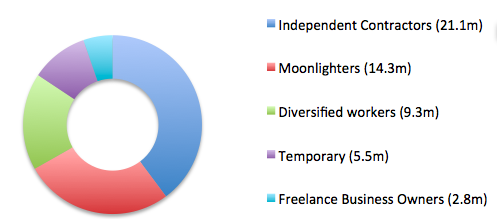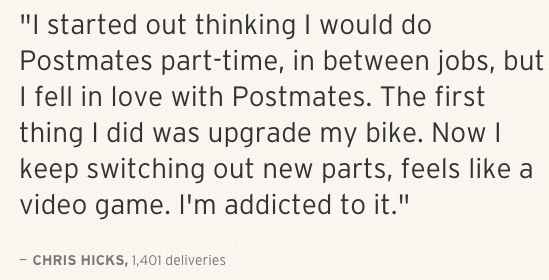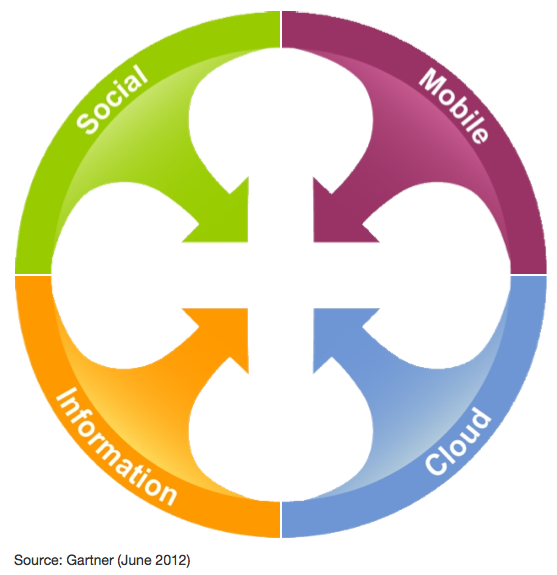The Internet evolved from publishing to e-commerce and then on to collaboration and communication. Now, it's a powerful engine for disruption that harnesses a crowdsourced workforce. Not only are industries being disrupted but entire business and organizational models are being challenged—at pace.
The Nexus of Forces (social, mobile, cloud, and information) as Gartner termed them is driving this disruption. But to harness these forces requires sophisticated IT support: back-end server applications linked to elegant websites and mobile apps that are able to scale rapidly to support international expansion and connect customers with the crowdsourced workforce. This is a technical architecture challenge that requires exceptional UX design skills and a mastery of new development technologies. It's an opportunity for the entrepreneurial, business-savvy founders of these new companies and an equally large opportunity for the DevOps founders.
The new definition of "work"
This opportunity has arisen because the traditional model of where, how, and by whom work is delivered is now in question. Historically, the core activities of a company were delivered by employees or contractors who had a strong relationship with the company. Supporting activities may be outsourced to third-party firms who are specialists in areas such as HR, procurement, finance, and IT. But these are easily delivered by a third party because they don't directly impact the core proposition, reputation, or brand of the company—they're support services. It's generally accepted that the core processes of a company are too critical to leave to a third party, unless there's a strong contractual relationship and cultural fit.
However, that appears to be changing. Crowdsourcing is now overtaking outsourcing in every area of business, not just support services. Crowdsourcing is different from outsourcing in that the work is being delivered by a number of individuals, each of whom has a separate relationship with the company. With outsourcing, the work is delivered by a third party by its own team of employees.
The benefits of the crowdsourcing approach are huge, including wage arbitrage and access to an almost infinite resource pool. These benefits outweigh the management headaches and the risks. Technology is now making the management of the "crowd" and the allocation of work easier, but the risks are difficult to mitigate.
Future tense?
They say the future is already here. It's just not evenly distributed. In some industries, we can already see a strong dependence on the crowdsourced market, while in other industries we see none.
The largest example is the contract marketplace: design, marketing, and IT development. An independent study commissioned by the Freelancers Union and Elance-oDesk revealed that there are 53 million freelancers in the US, which represents 34 percent of the workforce. The survey defined freelancers as "individuals who have engaged in supplemental, temporary, or project- or contract-based work in the past 12 months." No wonder the polite question to ask these days isn't "Where do you work?" but "What are you working on?"
So, who are the 53 million?

New "Uber for X" business models
The ability to access a willing and distributed workforce—not just tech contractors—is opening up new opportunities to disrupt or aggregate existing industries and create new markets. Uber is tapping into a resource pool of owner/drivers who work as taxi drivers for as little or as much of their time as they want. And now there are a slew of "Uber for X" companies that are recruiting and engaging an independent workforce and connecting them with their customers. Below is just a sample of the opportunities made available due to crowdsourcing. As you look at the list, consider the technical and operational challenges for each. None of them are as simple as spinning up a website:
- Couriers (www.instacart.com, postmates.com, nimblme.com, getmeadow.com)
- Domestic cleaning (tryhousecall.com, hassle.com)
- Snow removal on demand (plowme.com)
- Industry expertise/analysts (guidepointglobal.com)
- Technology and design (fivver.com, elance.com, upwork.com)
- Errands and small tasks (taskrabbit.com)
- Roadside assistance (roadangels.com.au)
And the list is growing daily.
There's a clear pattern. At the moment, these are all companies aimed at B2C or B2SmallB where the buyer is less risk averse, but that could change as new companies become more established and build up a visible track record of consistent delivery. Business people are happy to rely on an Uber arriving in time to get them to the airport or a meeting.
Engaging a new workforce

What's interesting is that many of the people who are working for these new companies started part time using skills (car repair, cleaning, plowing) or resources (time, cars, bikes) they already have. Most Uber drivers are car drivers who want to make additional money and need the flexibility to work around their schedules. They're not career taxi drivers. While the pay for some of these jobs isn't substantial, having the ability to earn money in their free time makes it worthwhile to the workers. Workers can also strategically combine several services to earn additional money.
These new companies are bringing a whole new group of people into the workforce because they've made the process of finding customers, delivering a service, and getting paid easy for the worker. This is where technology is the key enabler—many of these businesses couldn't even exist without sophisticated IT support.
Execution is critical: Think friction-free
Don't underestimate the importance of a well designed end-to-end process. If you think about the core operations of these new companies, it's clear how strong a role technology plays in each area. To be able to scale profitably, these companies need to be as friction-free as possible, with little to no human intervention. Here are the key activities:
- Create demand: website, ads, social media
- Take customer orders: self-serve website, customer mobile app
- Recruit workers: website, ads, social media
- Worker application: website, worker mobile app
- Validation/certification of worker: back-office app, worker mobile app
- Match customer with worker: back-office app, worker mobile app
- Take payment from customer: website, customer mobile app
- Pay worker: back-office app, website, worker mobile app
- Track feedback on worker: website, customer mobile app
- Customer referral: website, customer mobile app, social media
- Optimize business: back-office app, big data, and reporting
The apps should be intuitive and offer self-service capabilities, with no training required. They should also be available 24 hours per day, because the company has little control over when or where customers and workers will access the website and apps. The focus must be on UX and performance. Finally, the company needs to be built so that it can scale rapidly, internationally. This is a big ask for a startup—it requires funding and strong business and technical skills.
The technologies
Gartner coined the phrase the Nexus of Forces: "Research over the past several years has identified the independent evolution of four powerful forces: social, mobile, cloud and information. As a result of consumerization and the ubiquity of connected smart devices, people's behavior has caused a convergence of these forces."

What's also making these new companies possible are the current technology platforms that enable elegant applications to be built quickly to capitalize on the Nexus of Forces. Equally critical are the hosting platforms that allow peaks in demand to be accommodated and APIs to connect easily to other data sources.
While each of these technologies is extremely powerful, it's the combination that creates the perfect storm. This has generated a deluge of new startups in the last few years. It's staggering to know that the Uber app appeared only five years ago.
Breaking through the status quo
Disrupting a whole industry sounds great, especially if you're determined to make your mark on society. But there are many people who have a vested interest in sticking to the status quo. They also have tremendous resources, including money, reputation, experience, and contacts.
The regulators. They're in place to protect the customer. Anyone can launch a service business and hire workers who lack the appropriate background, experience, and skills. These services, including transportation, healthcare, childcare, home/vehicle maintenance, courier, etc., could be putting the customer at risk, both financially and physically. Over time, customer feedback will weed out those workers who aren't delivering good service, but a few bad customer experiences amplified over social media may permanently damage the brand. So, while some regulation is behind the curve and feels too onerous, it can perform a critical role in other industries.
The incumbents. These are the big businesses who have no interest in breaking their established and profitable business models. With the ability to manipulate prices and lobby regulators to tie startups in red tape, they have enormous power in the marketplace.
Startups can be proactive by taking a process-driven approach to documenting and automating their end-to-end service so that they're protected when the regulators come knocking. "Startup" and "process" don't normally appear in the same sentence. But if the startup is attacking an industry with a strong regulatory environment, then this is table stakes.
As with many things, all this sounds far more difficult to achieve than it is in practice. It's tempting to put things off until the business grows. However, if you take the right approach and use the supporting technology, it's only a couple of weeks' worth of work to put the correct level of process documentation and governance in place. If it's developed early and the right culture is established, it'll be straightforward to maintain. You'll then have a far better idea of the back-office applications that need to be developed, the job specifications of the people you need to hire, and the right KPIs to drive and optimize the business.
Crowd control
The biggest risk to these new companies is their reputation. When relying on the crowd to deliver your service, how do you control quality, meet your customer promise (delivered in one hour or your money back), and balance customer demand with worker availability and expectations? All these are far smaller issues when you employ a workforce.
You may never see or meet the people in this new workforce. They're an email address, a profile, and a set of customer feedback scores in your system. This is such a new area that management styles and techniques, measurement and incentives, and recruitment approaches are still evolving. But just as outsourcing was once considered risky and is now mainstream, crowdsourcing will gradually gain acceptance. It may take the next five years to see these crowdsourcing models take hold in a wider range of businesses. The question isn't if, but when.
Everything is in place: the technology, potential customers, willing workers, and proven business models. We live in exciting times— unless you're an established business with a huge employed workforce.
Image source: Flickr
Keep learning
Choose the right ESM tool for your needs. Get up to speed with the our Buyer's Guide to Enterprise Service Management Tools
What will the next generation of enterprise service management tools look like? TechBeacon's Guide to Optimizing Enterprise Service Management offers the insights.
Discover more about IT Operations Monitoring with TechBeacon's Guide.
What's the best way to get your robotic process automation project off the ground? Find out how to choose the right tools—and the right project.
Ready to advance up the IT career ladder? TechBeacon's Careers Topic Center provides expert advice you need to prepare for your next move.


